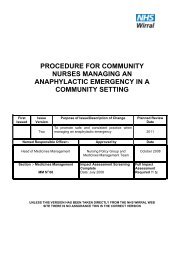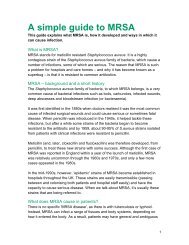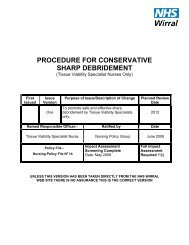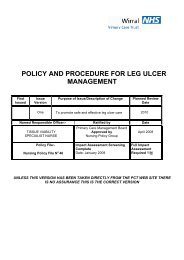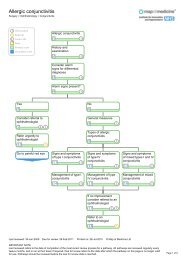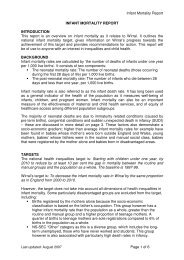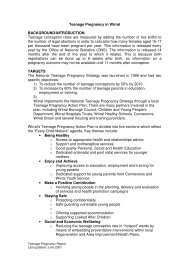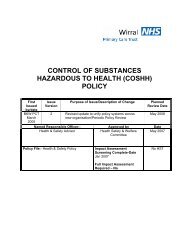guidelines for insertion of replacement balloon
guidelines for insertion of replacement balloon
guidelines for insertion of replacement balloon
You also want an ePaper? Increase the reach of your titles
YUMPU automatically turns print PDFs into web optimized ePapers that Google loves.
GUIDELINES FOR INSERTION OF REPLACEMENT BALLOONGASTROSTOMYThe training will be provided by the community dietetic team (0151 604 7271).The individual will be trained and deemed competent by the trust to per<strong>for</strong>m thisprocedure.The individual will carry out this procedure according to trust <strong>guidelines</strong>.BEFORE THE PROCEDURETHE INDIVIDUAL WILL;1. Plan to routinely change the gastrostomy tube every 3 – 4 months.2. Check the date the stoma was first <strong>for</strong>med. The stoma should be at least 6 weeksold to facilitate safe <strong>replacement</strong> and prevent complications such as peritonealleakage and peritonitis.3. Be aware that any tube <strong>replacement</strong>s necessary be<strong>for</strong>e 6 weeks should be referredto the appropriate endoscopist.4. Be responsible <strong>for</strong> obtaining in<strong>for</strong>med consent from the patient prior to theprocedure.5. Provide a full explanation <strong>of</strong> the procedure (and associated risks).6. Ensure the feed has been suspended <strong>for</strong> 2 hours prior to commencing theprocedure.7. Check that the appropriate equipment is available to per<strong>for</strong>m the procedure.EQUIPMENT• 2 gastrostomy tubes. The <strong>replacement</strong> tube should be the same Fr size as theexisting tube. The other tube should be a Fr size smaller.• Pre-filled syringe/ 20ml luer slip syringe and a 20ml ampule <strong>of</strong> sterile water.• Water soluble lubricating jelly if included in the gastrostomy tube kit.• 20ml luer slip syringe.• 50ml catheter-tipped syringe.• Litmus paper/ PH indicator sticks.
DURING THE REMOVAL PROCEDURETHE INDIVIDUAL WILL;1. Assist the patient into a com<strong>for</strong>table position lying as flat as the patient will allow.2. Identify the type and size <strong>of</strong> the feeding tube insitu and <strong>of</strong> the <strong>replacement</strong> tube.3. Be aware <strong>of</strong> the <strong>balloon</strong> inflation volume <strong>for</strong> the <strong>replacement</strong> tube (on inflationvalve). Inflate the <strong>balloon</strong> with 5ml/ 20ml <strong>of</strong> sterile water to inspect the <strong>balloon</strong><strong>for</strong> leaks using a 20ml luer slip syringe. Deflate the <strong>balloon</strong>.4. Check the existing tube rotates and moves freely within the stoma tract.5. Flush the tube with 50ml cooled boiled water.6. Deflate the <strong>balloon</strong> with a 20ml luer slip syringe. Expect approximately 5ml <strong>for</strong> a12, 14 or 18Fr tube and 20ml <strong>for</strong> a 16 or 20Fr tube.7. Hold the tube close to the stomach with one hand and apply gentle pressure to theabdomen.8. Pull the tube until it comes out <strong>of</strong> the stoma. If you encounter significantresistance, stop the procedure. Push the existing tube back into the stoma andinflate the <strong>balloon</strong> with 5ml/ 20ml <strong>of</strong> sterile water. Contact the patient’s Dietitian,gastro specialist nurse or G.P.9. Wipe the site with gauze to remove any gastric secretions.DURING THE REPLACEMENT PROCEDURETHE INDIVIDUAL WILL;1. Lubricate the end <strong>of</strong> the tube with a water soluble lubricant/ moisten the tip withcooled boiled water.2. Push the lubricated end into the stoma site and into the stomach (approximately8cm). If <strong>insertion</strong> <strong>of</strong> the new tube meets excessive resistance, try to insert thesmaller Fr size <strong>replacement</strong> tube. If unable to insert this tube, try with a smaller Frsize Foley catheter and contact the patient’s Dietitian, gastro specialist nurse andG.P. Do not use the Foley Catheter to feed.3. Inflate the <strong>balloon</strong> with 5ml/ 20ml <strong>of</strong> sterile water from either a pre-filled syringe/ampule.4. Pull the tube back until tension is felt from the <strong>balloon</strong> contacting the stomachwall.5. Push the bumper bar down the tube until it fits snugly but not tightly on thestomach.6. Wipe away any fluid or lubricant from the tube and stoma with gauze.7. Use a 50ml catheter-tipped syringe to aspirate gastric contents.8. Using litmus paper/ PH indicator sticks confirm correct placement. Litmus paperto turn red. If using PH indicator sticks 1 – 4 indicative <strong>of</strong> gastric placement, 5 ifon PPI or H 2 antagonist.9. Assess the condition <strong>of</strong> the stoma and the surrounding skin and report anyproblems such as inflammation, excoriation or infection to the patient’s Dietitian,gastro specialist nurse or G.P.
AFTER THE PROCEDURETHE INDIVIDUAL WILL;1. Document the procedure to include• Type <strong>of</strong> tube• Size <strong>of</strong> tube• Description <strong>of</strong> <strong>insertion</strong>• Date <strong>of</strong> <strong>insertion</strong>• Date tube to be replaced in future• Amount <strong>of</strong> water inserted into the <strong>balloon</strong>• Stoma condition.2. Advise the patient and carer <strong>of</strong> the action to take if the tube is displaced.3. Ensure the patient has a spare <strong>replacement</strong> tube <strong>of</strong> the appropriate type and sizeThe successful procedure is to be observed by the trainer 5 times be<strong>for</strong>e the assessmentcan be completed and the individual be deemed as competent.To remain competent, the individual will carry out this procedure a minimum <strong>of</strong> 6 timesper year.ONGOING CAREDAILY PERSONAL CARE;1. Wash your hands with soap and water. Dry them thoroughly. Ideally weardisposable vinyl gloves.2. Loosen bumper bar away from the stoma site.3. Check the skin surrounding the gastrostomy tube <strong>for</strong> redness, soreness, skinirritation, swelling or leakage. If you find any <strong>of</strong> these, contact the patient’sDietitian, gastro specialist nurse or G.P.4. Clean the skin around the tube with warm soapy water.5. Dry the area thoroughly and replace the bumper bar so it fits com<strong>for</strong>tably on thestomach.6. Gently rotate the tube 360º and move the tube in and out <strong>of</strong> the stoma tract.7. Do not use talcum powder, creams or dressings on the site unless prescribed <strong>for</strong>this area.8. Brush teeth, gums and tongue at least twice a day using toothpaste and atoothbrush.9. A medicated mouthwash may be necessary.10. If the patient’s lips are dry, use a lip balm/ moisturising cream to soothe these.




